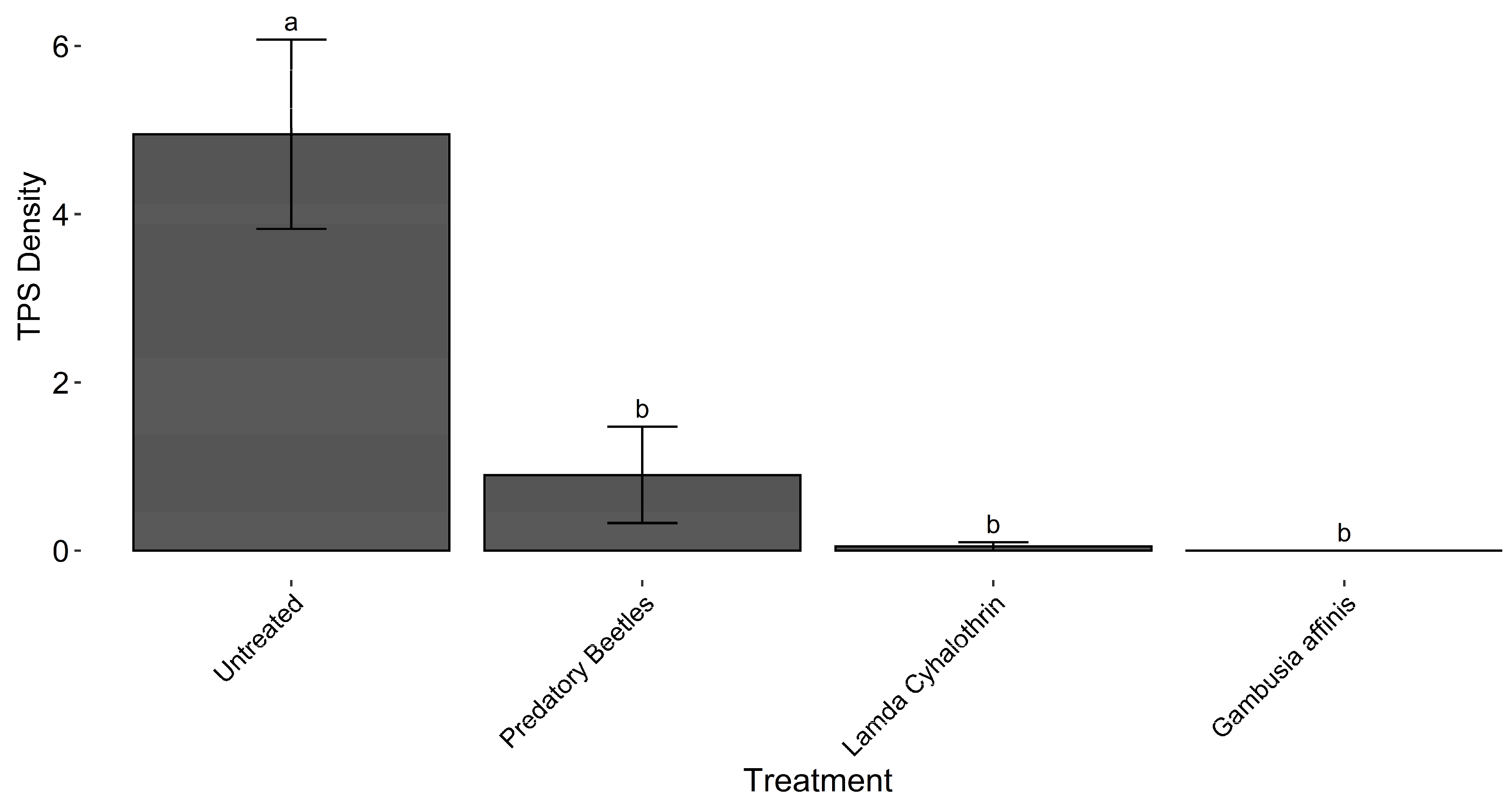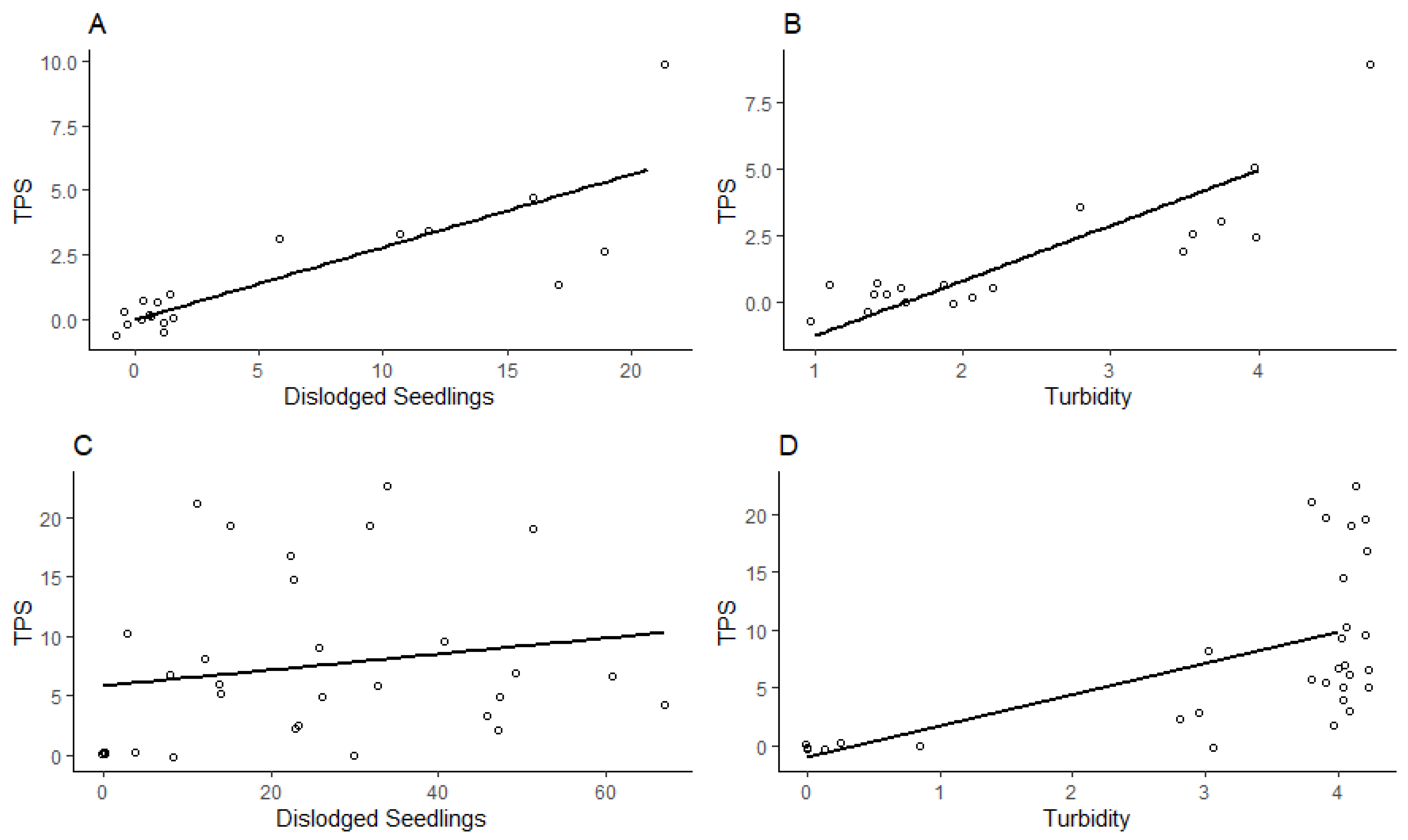Biological Control Options for the Management of Tadpole Shrimp (Triops longicaudatus (LeConte)) in California Rice
Abstract
1. Introduction
1.1. TPS Biology
1.2. TPS Monitoring
2. Materials and Methods
2.1. 2017 Field Trial: Efficacy of Gambusia affinis and Predatory Beetles at Controlling TPS
2.2. 2018 Field Trial: Comparing Different Application Rates against Previous Successful Rates
2.3. Assessing Monitoring Practices
2.4. Statistical Analysis
3. Results
4. Discussion
Considerations for the Use of Gambusia in Rice Paddies
5. Summary
Supplementary Materials
Author Contributions
Funding
Institutional Review Board Statement
Data Availability Statement
Acknowledgments
Conflicts of Interest
References
- Linder, F. Contributions to the morphology and taxonomy of the Branchiopoda Notostraca with special reference to the North American species. Proc. U. S. Natl. Mus. 1952, 102, 69. [Google Scholar] [CrossRef]
- Longhurst, A.R. A review of the Notostraca. Bull. Br. Mus. Zool. 1955, 3, 57. [Google Scholar] [CrossRef]
- Scholnick, D.A. Sensitivity of metabolic rate, growth and fecundity of tadpole shrimp, Triops longicaudatus to environmental variation. Biol. Bull. 1995, 189, 22–28. [Google Scholar] [CrossRef] [PubMed][Green Version]
- Fry, L.L.; Mulla, M.S. Optimal conditions for rearing the tadpole shrimp, Triops longicaudatus (Notostraca: Triopsidae), A biological control agent against mosquitoes. J. Am. Mosq. Control Assoc. 1996, 12, 446–453. [Google Scholar]
- Maffi, M. Triops granaries (Lucas) (Crustacea) as a natural enemy of mosquito larvae. Nature 1962, 195, 722. [Google Scholar] [CrossRef]
- Tietze, N.S.; Mulla, M.S. Prey size selection by Triops longicaudatus (Notostraca: Triopsidae) feeding on immature stages of Culex quinquefasciatus. J. Am. Mosq. Control Assoc. 1989, 5, 392–396. [Google Scholar] [PubMed]
- Tietze, N.S.; Mulla, M.S. Influence of the tadpole shrimp, Triops longicaudatus (Notostraca: Triopsidae), stocking rate of Culex tarsalis development in experimental field microcosms. J. Am. Mosq. Control Assoc. 1990, 6, 265–269. [Google Scholar] [PubMed]
- Tietze, N.S.; Mulla, M.S. Biological control of Culex mosquitoes (Diptera: Culicidae) by the tadpole shrimp, Triops longicaudatus (Notostraca: Triopsidae). J. Med. Entomol. 1991, 28, 24–31. [Google Scholar] [CrossRef]
- Fry, L.L.; Mulla, M.S.; Adams, C.W. Field introduction and establishment of the tadpole shrimp, Triops longicaudatus (Notostraca: Triopsidae), a biological control agent of mosquitoes. Biol. Control 1994, 4, 113–124. [Google Scholar] [CrossRef]
- Amazon Inc. Toyops. 2019. Available online: https://www.amazon.com/Toyops-HG24TRI-Triops-Hanging-Kit/dp/B003L2CQBK/ref=sr_1_3?keywords=Tadpole+shrimp&qid=1553536366&s=hpc&sr=8-3/ (accessed on 25 March 2019).
- Grigarick, A.A.; Lange, W.H.; Finfrock, D.C. Control of the tadpole shrimp, Triops longicaudatus, in California rice fields. J. Econ. Entomol. 1961, 54, 36–40. [Google Scholar] [CrossRef]
- Rosenberg, L.E. Apus as a pest in California rice fields. Calif. Dep. Agric. Bull. 1947, 36, 42–48. [Google Scholar]
- Grigarick, A.A. Rice plant injury: By invertebrate pests. Calif. Agric. 1963, 17, 6–7. [Google Scholar]
- Grigarick, A.A.; Lynch, J.H.; Way, J.O. Controlling Tadpole Shrimp. California Agriculture March–April 1985; pp. 12–13. Available online: http://calag.ucanr.edu/archive/?type=pdf&article=ca.v039n03p12 (accessed on 5 March 2019).
- Linquist, B.; Fischer, A.; Godfrey, L.D.; Greer, C.; Hill, J.; Koffler, K.; Moeching, M.; Mutters, R.; van Kessel, C. Minimum tillage could benefit California rice farmers. Calif. Agric. 2008, 62, 24–29. [Google Scholar] [CrossRef]
- UCCE. University of California Cooperative Extension (UCCE) Rice Production Manual. 2015. Available online: http://rice.ucanr.edu/Stand_Establishment/ (accessed on 23 February 2019).
- UCCE. University of California Cooperative Extension (UCCE) Rice Production Manual. 2018. Available online: http://rice.ucanr.edu/Stand_Establishment/ (accessed on 23 February 2019).
- Takahashi, F. Pioneer life of tadpole shrimp, Triops spp. (Notostraca:Triopsidea). Appl. Entomol. Zool. 1977, 12, 104–117. [Google Scholar] [CrossRef]
- Linquist, B.; Koffler, K.; Hill, J.; van Kessel, C. Rice field drainage affects nitrogen dynamics and management. Calif. Agric. 2011, 65, 80–84. [Google Scholar] [CrossRef]
- Bird, J.A.; Eagle, A.J.; Horwath, W.R.; Hair, M.W.; Zilbert, E.E.; van Kessel, C. Long-term studies find benefits, challenges in alternative rice straw management. Calif. Agric. 2002, 56, 69–75. [Google Scholar] [CrossRef]
- Report to the Legislature. Progress Report of the Phase Down of Rice Straw Burning in the Sacramento Valley Air Basin; California Air Resources Board; California Department of Food and Agriculture: Sacramento, CA, USA, 2000. [Google Scholar]
- ACC, American Commodity Company LCC. The Facts About California Rice Production, As Reported in Part from May 2012, Environmental Sustainability Report Prepared by the California Rice Commission. 2012. Available online: http://www.accrice.com/sustainability/the-facts-about-california-rice-production/ (accessed on 10 January 2019).
- Van Soest, P.J. Rice straw, the role of silica and treatments to improve quality. Anim. Feed Sci. Technol. 2006, 130, 137–171. [Google Scholar] [CrossRef]
- Blank, R. Spatial and temporal variation in the composition and biomass of algae present in selected California rice fields. J. Freshw. Ecol. 2006, 21, 649–656. [Google Scholar]
- DPR, Department of Pesticide Regulation. Summary of Pesticide Use Report Data. 2015. Available online: https://www.pesticidereform.org/wp-content/uploads/2021/01/ex_sum_15.pdf (accessed on 5 November 2016).
- Espino, L. TPS Control Issues. University of California, Agriculture and Natural Resources (UCANR) UC Rice Blog, California Rice Production. 2016. Available online: https://ucanr.edu/blogs/blogcore/postdetail.cfm?postnum=21130/ (accessed on 14 February 2019).
- Fischer, D.C. Rate of Evolution in Living Fossils. In Paleobiology; Briggs, D.E.G., Krauther, P.R., Eds.; Blackwell Scientific: London, UK, 1990; pp. 152–159. [Google Scholar]
- Mantovani, B.; Cesar, M.; Scanabissi, F. Molecular taxonomy and phylogeny of the ‘living fossil’ lineages Triops and Lepidurus (Branchiopoda: Notostraca) Academy of Science and Letter. Zool. Scr. 2004, 33, 367–374. [Google Scholar] [CrossRef]
- Boix, D.; Sala, J.; Gascón, S.; Brucet, S. Predation in a Temporary pond with special attention to the trophic role of Triops cancriformis (Crustacea: Branchiopoda: Notostraca). Hydrobiologia 2006, 571, 341–353. [Google Scholar] [CrossRef]
- Hengherr, S.; Heyer, A.G.; Brümmer, F.; Schill, R.O. Trehalose and Vitreous States: Desiccation Tolerance of Dormant Stages of the Crustaceans Triops and Daphnia. J. Physiol. Biochem. Zool. 2011, 84, 147–153. [Google Scholar] [CrossRef] [PubMed]
- Igarishi, K. Ecological studies on Triops longicaudatus (Notostraca) inhabiting Shonai District, Japan. J. Yamagata Agric. Soc. 1970, 23, 33–39. [Google Scholar]
- Scott, S.R.; Grigarick, A.A. Laboratory studies of factors affecting egg hatch of Triops longicaudatus (LeConte) (Notostraca: Triopsidae). Hydrobiologia 1979, 63, 145–152. [Google Scholar] [CrossRef]
- Fry, L.L.; Mulla, M.S. Effect of drying period and soil moisture on egg hatch of the tadpole shrimp (Notostraca: Triopsidae). J. Econ. Entomol. 1992, 85, 65–69. [Google Scholar] [CrossRef] [PubMed]
- Davis, J.M.; Madison, D. The Ontogeny of Light-Dark Response in Triops longicaudatus as a Response to Changing Selective Pressures. Crustaceana 2000, 73, 283–288. [Google Scholar] [CrossRef]
- Bloese, J.B.; Goding, K.M.; Godfrey, L.D. Alternative Chemical Control Options and Monitoring Techniques for Triops longicaudatus (Notostraca: Triopsidae) in California Rice. J. Econ. Entomol. 2022, 115, 273–278. [Google Scholar] [CrossRef] [PubMed]
- Aghaee, M.A.; Godfrey, L.D. The Efficacy of Bacillus thuringiensis spp. Galleriae Against Rice Water Weevil (Coleoptera: Curculionidae) for Integrated Pest Management in California Rice. J. Econ. Entomol. 2015, 108, 45–52. [Google Scholar] [CrossRef] [PubMed]
- Aghaee, M.A.; Espino, L.; Goding, K.M.; Goldman, E.; Godfrey, L.D. Effects of Seeding Rates and Rice Water Weevil (Coleoptera: Curculionidae) Density on Damage in Two Medium Grain Varieties of Rice. J. Econ. Entomol. 2016, 109, 667–675. [Google Scholar] [CrossRef] [PubMed]
- California Mosquito & Vector Control. Controlling Mosquitoes with Mosquito Fish. Clarkcountynv.gov. 1991. Available online: https://webfiles.clarkcountynv.gov/Public%20Works/Vector/Controlling%20Mosquitoes%20with%20Mosquito%20Fish.pdf (accessed on 2 March 2021).
- Pyke, G.H. A review of the biology of Gambusia affinis and G. holbrooki. Rev. Fish Biol. Fish. 2005, 15, 339–365. [Google Scholar] [CrossRef]
- Otto, R.G. Temperature tolerance of the mosquitofish, Gambusia affinis (Baird and Girard). J. Fish Biol. 1973, 5, 575–585. [Google Scholar] [CrossRef]
- Stearns, S.C.; Sage, R.D. Maladaption in a marginal population of the mosquito fish Gambusia affinis. Evolution 1980, 34, 65–75. [Google Scholar] [CrossRef] [PubMed]
- Miura, T.; Takahashi, R.M.; Wilder, W.H. Impact of the mosquito fish (Gambusia affinis) on a rice field ecosystem when used as a mosquito control agent. Mosq. News. 1984, 44, 510–517. [Google Scholar]
- Bence, J.R.; Murdoch, W.W. Prey size selection by the mosquitofish Gambusia affinis relation to optimal diet theory. Ecology 1986, 67, 324–336. [Google Scholar] [CrossRef]
- Wurtsbaugh, W.; Cech, J.J.; Compton, J. Effect of fish size on prey size selection in Gambusia affinis. Proc. Calif. Mosq. Vector Control Assoc. 1980, 48, 48–51. [Google Scholar]
- Farley, D.G.; Younce, L.C. Stocking date versus efficacy of Gambusia affinis in Fresno County rice fields. Proc. Calif. Mosq. Vector Control Assoc. 1977, 45, 83–86. [Google Scholar]
- Hoy, J.B.; Reed, D.E. Biological control of Culex tarsalis in a California rice field. Mosq. News. 1970, 30, 222–230. [Google Scholar]
- Hoy, J.B.; Reed, D.E. The efficacy of mosquitofish for control of Culex tarsalis in California rice fields. Mosq. News. 1971, 31, 567–572. [Google Scholar]



| 2017 Field Trial | 2018 Field Trial | ||||
|---|---|---|---|---|---|
| Trt | Rate | Trt | Rate | ||
| 1 | Untreated | N/A | 1 | Untreated | N/A |
| 2 | Gambusia affinis (~4 cm in length) | Five Fish/ring | 2 | Gambusia affinis (~2 cm in length) | One fish/ring |
| 3 | Predatory beetles (Adult L. maculosus and Adult T. lateralis) | Ratio 3:2 | 3 | Gambusia affinis (~2 cm in length) | Two fish/ring |
| 4 | Industry Standard Lambda-cyhalothrin | Rate: 0.139 L/ha | 4 | Gambusia affinis (~2 cm in length) | Four fish/ring |
| 5 | Gambusia affinis (~2 cm in length) | Five fish/ring | |||
| 6 | Industry standard Lambda-cyhalothrin | Rate: 0.139 L/ha | |||
Disclaimer/Publisher’s Note: The statements, opinions and data contained in all publications are solely those of the individual author(s) and contributor(s) and not of MDPI and/or the editor(s). MDPI and/or the editor(s) disclaim responsibility for any injury to people or property resulting from any ideas, methods, instructions or products referred to in the content. |
© 2024 by the authors. Licensee MDPI, Basel, Switzerland. This article is an open access article distributed under the terms and conditions of the Creative Commons Attribution (CC BY) license (https://creativecommons.org/licenses/by/4.0/).
Share and Cite
Bloese, J.; Goding, K.; Godfrey, L. Biological Control Options for the Management of Tadpole Shrimp (Triops longicaudatus (LeConte)) in California Rice. Agriculture 2024, 14, 1136. https://doi.org/10.3390/agriculture14071136
Bloese J, Goding K, Godfrey L. Biological Control Options for the Management of Tadpole Shrimp (Triops longicaudatus (LeConte)) in California Rice. Agriculture. 2024; 14(7):1136. https://doi.org/10.3390/agriculture14071136
Chicago/Turabian StyleBloese, Joanna, Kevin Goding, and Larry Godfrey. 2024. "Biological Control Options for the Management of Tadpole Shrimp (Triops longicaudatus (LeConte)) in California Rice" Agriculture 14, no. 7: 1136. https://doi.org/10.3390/agriculture14071136
APA StyleBloese, J., Goding, K., & Godfrey, L. (2024). Biological Control Options for the Management of Tadpole Shrimp (Triops longicaudatus (LeConte)) in California Rice. Agriculture, 14(7), 1136. https://doi.org/10.3390/agriculture14071136







